Tromsø
| Tromsø kommune | |||
|---|---|---|---|
| — Municipality — | |||
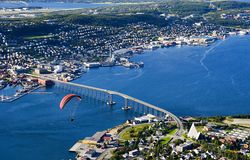 |
|||
|
|||
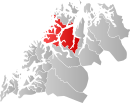 |
|||
| Coordinates: | |||
| Country | Norway | ||
| County | Troms | ||
| District | Nord-Troms | ||
| Administrative centre | Tromsø | ||
| Government | |||
| - Mayor (2007) | Arild Hausberg (Ap) | ||
| Area | |||
| - Total | 2,523.93 km2 (974.5 sq mi) | ||
| - Land | 2,480.34 km2 (957.7 sq mi) | ||
| - Water | 43.59 km2 (16.8 sq mi) | ||
| Area rank | 18 in Norway | ||
| Population (2010) | |||
| - Total | 67,305 | ||
| - Rank | 8 in Norway | ||
| - Density | 27.1/km2 (70.2/sq mi) | ||
| - Change (10 years) | 13.8 % | ||
| Demonym | Tromsøværing[1] | ||
| Time zone | CET (UTC+1) | ||
| - Summer (DST) | CEST (UTC+2) | ||
| ISO 3166 code | NO-1902 | ||
| Official language form | Neutral | ||
| Website | tromso.kommune.no | ||
|
|
|||
Tromsø (also: Romsa[2] in Northern Sami and Tromssa in Kven) is a city and municipality in Troms county, Norway. The administrative centre of the municipality is the city of Tromsø.
Tromsø city is the ninth largest urban area in Norway by population,[3] and the seventh largest city in Norway by population.[4] It is the largest city and the largest urban area in Northern Norway, and the second largest city and urban area in Sápmi (following Murmansk).
The area has been inhabited since the end of the ice age, and the Sámi culture is the first known culture of the region. Speakers of Norse, the ancestor of Norwegian brought their culture to the area during the migrations of the Vikings before AD 890, when Ohthere's settlement existed to the south of today's Tromsø. The first church on the island of Tromsøya was erected in the 13th century, and the area is one of Denmark–Norway's very northernmost territories not contested by Russia. During the 1600s, Denmark–Norway solidified its claim to the northern coast of Scandinavia and during this period a redoubt, Skansen, was built. Tromsø was issued its city charter in 1794 by King Christian VII. The city was established as a municipality 1 January 1838 (see formannskapsdistrikt). The rural municipalities of Tromsøysund and Ullsfjord, and most of Hillesøy, were merged with Tromsø on 1 January 1964. The population of Tromsø municipality is 63,596, and the urban area, Norway's ninth most populous, is home to 53,622 people.[5]
Most of Tromsø, including the city centre, is located on the small island of Tromsøya in the county of Troms, 350 kilometres (217 mi) inside the arctic circle. The island is connected to the mainland by the Tromsø Bridge and the Tromsøysund Tunnel, and to the island of Kvaløya by the Sandnessund Bridge. The city is warmer than most other places located on the same latitude, due to the warming effect of the Gulf Stream.
The city centre of Tromsø contains the highest number of old wooden houses in Northern Norway, the oldest house dating from 1789. The Arctic Cathedral, a modern church from 1965, is probably the most famous landmark in Tromsø. The city is a cultural centre for its region, several festivals taking place in the summer. The largest football team in the city, Tromsø I.L, plays in the Norwegian Premier League.
Contents |
History
The area was first settled at the end of the ice age. The Sámi culture is indigenous to the region, but the Norse culture arrived quite early on the scene - sometime in the early Medieval Age. The first church, Ecclesia Sanctae Mariae de Trums juxta paganos ("The Church of Saint Mary in Troms near the Heathens"), was built in 1252 during the reign of King Hákon Hákonarson.[6] At the time, it was the northernmost church in the world. Around the same time, a turf rampart was built to protect the area against raids from Karelia and Russia.
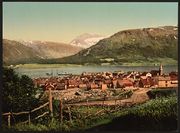
Despite only being home to around 80 people, Tromsø was issued its city charter in 1794. However, the city quickly rose in importance. The diocese of Hålogaland was created in 1804, with the first bishop being Mathias Bonsach Krogh.[7] A teacher training college and the first shipyard were established in 1848, followed by the predecessor of the University of Tromsø, the Tromsø Museum, in 1872,[8] and the Mack Brewery in 1877.[9]
In the 19th century, Tromsø was known as the "Paris of the North", probably because people in Tromsø appeared as far more civilized than expected to foreign tourists.[10]
Arctic hunting, from Novaya Zemlya to Canada, started up around 1820. By 1850, Tromsø was the major center of Arctic hunting, overtaking the former center of Hammerfest, and the city was trading from Arkhangelsk to Bordeaux. By the end of the 19th century, Tromsø had become a major Arctic trade center from which many Arctic expeditions originated. Explorers like Roald Amundsen, Umberto Nobile and Fridtjof Nansen made use of the know-how in Tromsø on the conditions in the Arctic, and often recruited their crew in the city. The Northern lights observatory was founded in 1927.
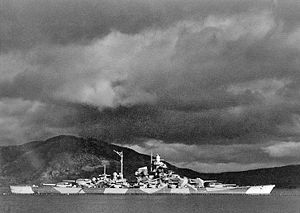
During World War II, General Carl Gustav Fleischer arrived in Tromsø on 10 April 1940 after flying in terrible conditions. From Tromsø he issued orders for total civilian and military mobilisation and declared North Norway a theatre of war. Fleischer's strategic plan was to first wipe out the German forces at Narvik and then transfer his division to Nordland to meet a German advance from Trøndelag. The Battle of Narvik was the first major allied victory on land in the Second World War.
Tromsø served briefly as the seat of Norwegian government. However, the city escaped the war without any damage, although the German battleship Tirpitz was sunk off the Tromsøy island on 12 November 1944, when close to 1,000 German soldiers died.[11][12] At the end of the war, the city received thousands of refugees from the Finnmark province, which was evacuated and devastated by German forces at the time in expectation of the Red Army offensive.
Expansion after World War II has been rapid. The population growth has been strong, some years more than 1,000 people. The present municipal borders were created through the merger of Tromsø, Hillesøy, Tromsøysund and most of Ullsfjord in 1964, almost tripling the population from 12,430 to 32,664.[13] Tromsø Airport opened in 1964, the University of Tromsø in 1972 and the Norwegian Polar Institute was relocated to Tromsø from Oslo in 1998.
Toponymy
Tromsø has been named after the island of Tromsøya, which it is situated on. While the last element of the city's name comes from Danish ø which means "island" (Norwegian: øy), the etymology of the first element is uncertain. Several theories exist. One theory holds "Troms-" to derive from the old (uncompounded) name of the island (Old Norse: Trums). Several islands and rivers in Norway have the name Tromsa, and the names of these are probably derived from the word straumr which means "(strong) stream". (The original form must then have been Strums, for the missing s see Indo-European s-mobile.) Another theory holds that Tromsøya was originally called Lille Tromsøya (Little Tromsøya), because of its proximity to the much bigger island today called Kvaløya, that according to this theory was earlier called "Store Tromsøya" due to a characteristic mountain known as Tromma (the Drum). The mountain's name in Sámi, Rumbbučohkka, is identical in meaning, and it is said to have been a sacred mountain for the Sámi in pre-Christian times.
The Sámi name of the island, Romsa, is assumed to be a loan from Norse - but according to the phonetical rules of the Sami language the frontal t has disappeared from the name. However, an alternative form - Tromsa - is in informal use. There is a theory that holds the Norwegian name of Tromsø derives from the Sámi name, though this theory lacks an explanation for the meaning of Romsa. A common misunderstanding is that Tromsø's Sámi name is Romssa with a double "s". This, however, is the accusative and genitive form of the noun used when, for example, writing "Tromsø Municipality" (Romssa Suohkan).
Coat of arms
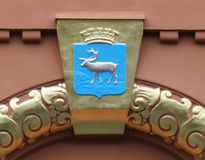 |
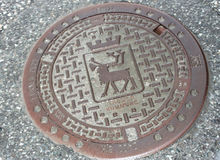 |
|
|
Shown above the entrance of a 1910 bank building
|
Trætteberg's 1941 rendering is engraved into many of the city's manhole covers.
|
The coat of arms of Tromsø kommune had its inception in 1870. The official blazon in Norwegian ("I blått en gående sølv rein") translates to "On a field Azure a reindeer trippant Argent".[14] The coat of arms has traditionally been displayed on an escutcheon of a modern French type. A mural crown with five turrets traditionally surmounts the escutcheon. The greaty stylised rendering (including the mural crown) which is currently being used by the municipal administration was drawn by Hallvard Trætteberg (1898–1987) and adopted by royal resolution on 24 September 1941.[15] In addition to stylising the reindeer charge, Trætteberg's design reduces the number of turrets on the mural crown from five to four, and straightens the base of the escutcheon. Tromsø's coat of arms is one of six Norwegian municipal coats of arms to include one or more reindeers or reindeer antlers as charges. The other five are those of Eidfjord, Porsanger, Rendalen, Vadsø, and Vågå.
Geography
Tromsø is the eighth-largest municipality in Norway with a population 63,596, and the centre of the ninth-largest urban area, with a population of 53,622.[5] The city is home to the world's second most northerly university after UNIS in Svalbard (the ])and also houses the most northerly brewery, botanical garden[16] and planetarium.[17]
The city center is located on the east side of the Tromsøya — over 300 km inside the Arctic Circle at . Suburban areas include Kroken, Tromsdalen (on the mainland, east of the Tromsøya island), the rest of the Tromsøya island, and the eastern part of the large Kvaløya, west of the Tromsøya Island. Tromsø Bridge and a four laned road tunnel connects the mainland with Tromsøya by road, and, on the western side of the city, Sandnessund Bridge connects Tromsøya island with Kvaløya island.

A railway connection to Narvik has been proposed.
Climate
Tromsø experiences a continental subarctic climate (Köppen climate classification Dfc) because winter temperatures are just cold enough to qualify and the summer season is short. However, the weather and precipitation amount and pattern, with maximum precipitation in autumn and early winter, as well as lack of permafrost, are atypical for subarctic areas, so this climate is sometimes called maritime subarctic or oceanic boreal. Tromsø has a reputation in Norway for getting a lot of snow in the winter, although this varies a lot from one year to the next. The all-time record was set 29 April 1997, when the meteorological station on top of Tromsøya recorded 240 centimetres (94.5 in) of snow. The lowest temperature ever recorded is −20.1 °C (−4.2 °F), on 16 February 1985.[18] However, the January average daily maximum is −2 °C (28.4 °F). This has long been thought to be due to the relatively warm North Atlantic Current, an extension of the Gulf Stream, but northern Europe's mild climate has been shown to be due to intercontinental weather patterns driven by North America's mountain ranges. However, the large anomaly along the coast of North Norway can not be explained without the mild Norwegian current.[19]. The proximity to the sea moderates temperatures; Sommarøy, on the west coast of Kvaløya, has January 24-hr average of −1.9 °C (29 °F). Summer is rather cool, with a July 24-hour average of 12 °C (53.6 °F); daytime temperatures are usually slightly warmer, but vary from 9 °C (48.2 °F) to 25 °C (77.0 °F). The summer of 1972, which is the warmest in the record, had a mean temperature of 12.9 °C (55.2 °F) and the highest temperature reached was 30 °C (86.0 °F) ([1]). The warmest year on record is 2005, with a mean temperature of 4.38 °C (39.88 °F), compared to the current annual average of about 3 °C (37.4 °F).[20] Large areas in the municipality are above the treeline and have an alpine tundra climate.
| Climate data for Tromsø (1961-90) | |||||||||||||
|---|---|---|---|---|---|---|---|---|---|---|---|---|---|
| Month | Jan | Feb | Mar | Apr | May | Jun | Jul | Aug | Sep | Oct | Nov | Dec | Year |
| Average high °C (°F) | -2.2 (28) |
-2.1 (28.2) |
-0.4 (31.3) |
2.7 (36.9) |
7.5 (45.5) |
12.5 (54.5) |
15.3 (59.5) |
13.9 (57) |
9.3 (48.7) |
4.7 (40.5) |
0.7 (33.3) |
-1.3 (29.7) |
5.4 (41.7) |
| Daily mean °C (°F) | -4.4 (24.1) |
-4.3 (24.3) |
-2.8 (27) |
0.3 (32.5) |
4.8 (40.6) |
9.3 (48.7) |
12.0 (53.6) |
10.9 (51.6) |
6.9 (44.4) |
2.7 (36.9) |
-1.2 (29.8) |
-3.4 (25.9) |
2.2 (36) |
| Average low °C (°F) | -6.5 (20.3) |
-6.5 (20.3) |
-5.1 (22.8) |
-2.2 (28) |
2.0 (35.6) |
6.1 (43) |
8.7 (47.7) |
7.8 (46) |
4.4 (39.9) |
0.7 (33.3) |
-3.0 (26.6) |
-5.4 (22.3) |
-1.0 (30.2) |
| Precipitation mm (inches) | 95 (3.74) |
87 (3.43) |
72 (2.83) |
64 (2.52) |
48 (1.89) |
59 (2.32) |
77 (3.03) |
82 (3.23) |
102 (4.02) |
131 (5.16) |
108 (4.25) |
106 (4.17) |
1,031 (40.59) |
| Sunshine hours | 2.1 | 31.8 | 112.4 | 160.1 | 218.1 | 220.9 | 205.1 | 167.2 | 92.1 | 47.6 | 6.2 | 0.0 | 1,263.6 |
| Source: [21] | |||||||||||||
Light and darkness

The Midnight Sun occurs from about 18 May to 26 July, although the mountains in the north block the view of the midnight sun for a few days, meaning that one can see the sun from about 21 May to 21 July. Owing to Tromsø's high latitude, twilight is long, meaning there is no real darkness between late April and mid-August.
The sun remains below the horizon during the Polar Night from about 26 November to 15 January, but owing to the mountains the sun is not visible from 21 November to 21 January. The return of the sun is an occasion for celebration. However, because of the twilight, there is some daylight for a couple of hours even around midwinter, often with beautiful bluish light. The nights shorten quickly, and by 21 February the sun is above the horizon from 7:45 am to 4:10 pm, and 1 April from 5:50 am to 7:50 pm (daylight saving time).
The combination of snow cover and sunshine often creates intense light conditions from late February until the snow melts in the lowland (usually late April), and sunglasses are essential when skiing. Because of these diametrically different light conditions in winter, Norwegians often divide it into two seasons: Mørketid (Polar Night) and Seinvinter (late winter).
Tromsø is in the middle of the Aurora Borealis (Northern Lights) zone, and is in fact one of the best places in the world to observe this phenomenon. Because of the planet's rotation, Tromsø moves into the aurora zone around 6 pm, and moves out again around midnight. As it is light round the clock in the summer, no aurora is visible between late April and mid-August.
Villages
Tromsø includes these villages:
- Ersfjordbotn
- Kaldfjord
- Kjosen
- Movik
- Sommarøy
Cityscape
The compact city center is the biggest concentration of historic wooden houses north of Trondheim, that co-exist with modern architecture. The houses date from 1789 to 1904, when building wooden houses was banned in the city centre, like in several other Norwegian cities. The oldest house in Tromsø is Skansen, built in 1789 on the remains of a 13th century turf rampart.[22][23]
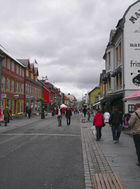
The Polar Museum, situated in a wharf house from 1837, presents Tromsø's past as a center for Arctic hunting and starting point for Arctic expeditions. The Tromsø Cathedral, Norway's only wooden cathedral, built in 1861, is located in the middle of the city, and so is the small Catholic church Vår Frue. Norway's oldest cinema is still in use, Verdensteatret, was built in 1915-16. The cinema has large wall paintings, made by the local artist Sverre Mack in 1921, that picture scenes from Norwegian folk lore and fairy tales.
The Arctic Cathedral, a modern church from 1965, is situated on the mainland, facing the sound and city centre. The church, in reality a parish church and not a cathedral, was drawn by Jan Inge Hovig and is probably the most famous landmark in Tromsø. The aquarium and experience center Polaria from 1998 is a short walk south from the city center. The Tromsø Museum is a university museum, presenting culture and nature of North Norway. The museum also displays the Arctic-alpine botanic garden, the world's northernmost botanical garden. A cable car goes up to mount Storsteinen, 421 metres above sea level, with a panoramic view over Tromsø. The mountain Tromsdalstinden, 1,238 metres (4,062 ft), on the mainland, which is easily spotted from the city center, is also a major landmark. On top of Tromsøya is lake Prestvannet.
Governance
The highest political body is the City Council (Bystyret), which elects a governing body, the Formannskap and five political committees. There is a discussion of whether to introduce city parliamentarism, as practiced in Oslo and Bergen. The Labour Party (AP), the Liberal Party (V), the Conservative Party (H) and the Progress Party (FrP) are advocating this political system, while the Socialist Left Party (SV) is opposing it.
The largest political party is the Labour Party. Although the Labour Party is led by Roger Ingebrigtsen, Labour's Arild Hausberg is mayor. The vice-mayor is Gunhild Johansen, from the Socialist Left Party.
Demographics
| Historical populations | ||
|---|---|---|
| Year | Pop. | %± |
| 1951 | 10,940 | — |
| 1960 | 12,283 | 12.3% |
| 1970 | 38,094 | 210.1% |
| 1980 | 45,833 | 20.3% |
| 1990 | 50,548 | 10.3% |
| 2000 | 59,145 | 17.0% |
| 2007 | 64,492 | 9.0% |
| Source: Statistics Norway The municipalities of Hillesøy, Tromsøysund and most of Ullsfjord were merged with Tromsø 1 January 1964. |
||
More than 100 nationalities are represented in the population, among the more prominent minorities are the Sami, Russians, and Finns, both the local Kvens and immigrants from Finland proper.[24] The world's northernmost mosque is to be found in Tromsø. The Our Lady Catholic church is the seat of the world's northernmost Catholic Bishop, although the Catholic population is only 350 heads strong — it is in this context interesting to note that Pope John Paul II visited this small church and stayed as a guest of the bishop in 1989.[25]
Sami population
The Sami minority is making itself felt, and there is a Sami kindergarten and Sami language classes in school. Sami was once spoken in communities throughout Tromsø, but use of the language declined during the 1900s' "Norwegianization" campaign. There are attempts to counter this trend, for example through the establishment of a Sami language center in Ullsfjord. Most Sami speakers in Tromsø migrated there from other Sami-speaking areas of the North.
Culture
Being the largest city in North Norway, Tromsø is a cultural centre for its region. It gained some international attention when it on 11 June 2005 hosted one of six 46664 concerts, designed to put work concerning HIV/AIDS on the international agenda. The concert was promoted by Nelson Mandela, whose prison number provided the arrangement's name, and featured international and local artists.

Many cultural activities take place in Kulturhuset (English: lit. the culture house), including concerts by Tromsø Symphony Orchestra and plays by Tromsø's professional theater troupe, Hålogaland Teater. The new theater building was opened in November 2005. The city contains several museums. The largest are the Northern Norwegian Art Gallery (Nordnorsk Kunstmuseum) and the Tromsø Gallery of Contemporary Art (Tromsø Kunstforening).
The Tromsø techno scene is the origin of many of Norway's most important artists in electronic music, and Tromsø was a leading city at the early stages of the house and techno scene in Norway from the last part of the 1980s.[26] The internationally recognized duo Röyksopp are the most famous exports.
The record label Beatservice Records and the Insomnia Festival makes Tromsø still leading in the country as of the development and promotion of the genre.
The local newspapers are Bladet Tromsø and Nordlys.
Festivals and celebrations
Both the Tromsø International Film Festival and Nordlysfestivalen (lit. the Aurora Festival), a classical music festival, are arranged in January. The end of that month is marked by the Day of the Sun (Soldagen), when the sun finally appearing above the horizon after the Polar Night is celebrated, mainly by children. The International Day of the Sami People is celebrated at the University of Tromsø and the city hall on 6 February every year. Tromsø's Latin American Festival, No Siesta Fiesta, is held at the end of February. It started in 2007 and showcases the best of "Latin America" in Northern Norway with film, dance, music, art, seminars, debates, markets, and a street Samba parade. Every autumn the Insomnia Festival for electronic music is hosted. It is one of the largest and most important festivals for electronic music and techno culture in Norway.
The Bukta Tromsø Open Air Festival, held in June and July, is a popular music festival. The Bukta festival is mainly a rock festival, but also features other kinds of modern music. The festival takes place in Telegrafbukta, a park on the south-western part of the Tromsøya island. Other popular cultural summer events among the population of Tromsø is the Karlsøy festival and the Riddu Riddu festival, both held in the region surrounding the city.
Sports

Tromsø is the home of many football (soccer) clubs, of which the three most prominent are Tromsø IL, which plays in the Norwegian Premier League and is the world's northermost Premier League football team, I.F. Fløya in the Norwegian Premier League for women, and Tromsdalen U.I.L., playing in the Adeccoliga. Tromsø Midnight Sun Marathon is arranged every year in June and recently also a Polar Night Half marathon in January. The city is home to many clubs in the top division in various sports. Most notably basketball-outfit Tromsø Storm in the BLNO, BK Tromsø in the top volleyball league for men, and Tromsø Volley in the top volleyball league for women. The oldest sports club in Tromsø is Tromsø Turnforening, a gymnastics club founded in 1862, that also was the cradle of the before mentioned football club Tromsø IL.
Tromsø was selected by the Norwegian National Olympic Committee as Norway's candidate for the 2018 Winter Olympics. This would have made Tromsø the first city north of the Arctic Circle to host the games. There were plans to use ships as the media village. In October 2008 the NOC suspended Tromso's bid, citing excessive costs.[27] From the southern to the northern tip of the island Tromsøya, there is a floodlit cross country ski track. A ski jump is also situated on the island, close to the university.
Famous residents
|
|
In popular culture
In the vampire thriller 30 Days of Night: Rumors of the Undead by Steve Niles and Jeff Mariotte (Pocket Books 2006), an FBI agent learns that Tromsø was depopulated in the winter of 1842, perhaps due to a mass vampire attack.
Norwegian director Erik Skjoldbjærgs debut movie Insomnia takes place in Tromsø.
The town of Trollesund, found in northern Norroway in the His Dark Materials series of books by Philip Pullman is supposedly based on the city of Tromsø.
The Nobel Prize winning author Knut Hamsun (1859–1952) published his first novel in a small bookshop in Tromsø in 1877.
International relations
Twin towns — Sister cities
Tromsø has eleven twin towns:[28]
| Sister City | Since | Country |
|---|---|---|
| Kemi | 1940 | |
| Luleå | 1950 | |
| Ringkøbing | 1950 | |
| Grimsby | 1961 | |
| Pune | 1966 | |
| Anchorage | 1969 | |
| Zagreb[29] | 1971 | |
| Murmansk | 1972 | |
| Quetzaltenango | 1999 | |
| Gaza | 2001 | |
| Nadym | 2008 |
References
- Notes
- ↑ "Personnemningar til stadnamn i Noreg" (in Norwegian). Språkrådet. http://www.sprakrad.no/Sprakhjelp/Rettskriving_Ordboeker/Innbyggjarnamn.
- ↑ Erroneously, the Sámi name is often believed to be "Romssa". This is because "Tromsø Municipality" is "Romssa Suohkan". Romssa, however is the genitive case, so that "Romssa Suohkan" translates to "the Municipality of Romsa".
- ↑ Norwegian Wikipedia, (Norwegian)
- ↑ Norwegian Wikipedia, (Norwegian)
- ↑ 5.0 5.1 Statistics Norway (1 January 2007). Urban settlements. Population and area, by municipality.. http://www.ssb.no/english/subjects/02/01/10/beftett_en/tab-2007-06-07-01-en.html.
- ↑ Diplomatarium Norvegicum b.1 nr.112, the Papal letter (in Latin) first referring to Troms
- ↑ "Biskoper i Hålogaland bispedømme 1804-1952". Den Norske Kirke. http://www.kirken.no/nord-haalogaland/tekstsider.cfm?id=110781. Retrieved 2007-11-03.
- ↑ "Om museet" (in Norwegian). Universitet i Tromsø. http://uit.no/tmu/152/. Retrieved 2007-11-03.
- ↑ "Fra ølvogn til mikrobryggeri". Macks Ølbryggeri AS. http://www.mack.no/index.php?cat=16535. Retrieved 2007-11-03.
- ↑ Destinasjon Tromsø - Facts about Tromsø
- ↑ "Bomber Command: Tirpitz 12 November 1944". RAF History Bomber Command 60th Anniversary. http://www.raf.mod.uk/bombercommand/tirpitz.html. Retrieved Accessed on April 27, 2008.
- ↑ 617 Squadron - The Operational Record Book 1943 - 1945 http://www.dambusters.org.uk/docs/recordbook.pdf www.dambusters.org with additional information by Tobin Jones; Binx Publishing, Pevensey House, Sheep Street, Bicester. OX26 6JF. Acknowledgement is given to HMSO as holders of the copyright on the Operational Record Book
- ↑ "1902 Tromsø. Population 1 January and population changes during the year. 1951-". Statistics Norway. 2007. http://www.ssb.no/english/subjects/02/02/folkendrhist_en/tables/tab/1902.html. Retrieved 2007-11-03.
- ↑ "TROMSØ". Arkivverket.no. 1941-09-24. http://www.arkivverket.no/webfelles/kommunevaapen/vaapen/tromsoe.html. Retrieved 2010-06-24.
- ↑ Coats-of-arms - National Archival services of Norway
- ↑ UIT.no (Norwegian)
- ↑ NordNorks.Vitensenter.no (Norwegian)
- ↑ Yr record cold in February
- ↑ "The source of Europe's mild climate". http://www.americanscientist.org/issues/feature/2006/4/the-source-of-europes-mild-climate/1.
- ↑ Average monthly climate data 1920 - 2008, GISS monthly climate records, Goddard Institute of Space Studies
- ↑ "Tromsø historic weather averages". World Weather Information Service, sunhours provided by met.no. http://www.worldweather.org/008/c00023.htm. Retrieved 2009-12-06.
- ↑ "Tromsø er «djevelsk stygg» - VG Nett om Reiselivsnyheter" (in Norwegian). Vg.no. 2008-08-21. http://www.vg.no/reise/artikkel.php?artid=525004. Retrieved 2010-05-29.
- ↑ Carina Hansen. "Forfall i hele byen - iTromso" (in Norwegian). Itromso.no. http://www.itromso.no/nyheter/article360981.ece. Retrieved 2010-05-29.
- ↑ Population in Tromsø by citizenship From Tromsø Municipality(Norwegian)
- ↑ Broen katolsk kirkeblad nr. 3 2004 A Norwegian church news magazine
- ↑ Aftenposten.no (Norwegian), 20 år med techno
- ↑ Tromso's Application Withdrawn - Aftenposten.no
- ↑ List of twin towns from Tromsø municipality (Norwegian)
- ↑ "Intercity and International Cooperation of the City of Zagreb". © 2006-2009 City of Zagreb. http://www1.zagreb.hr/mms/en/index.html. Retrieved 2009-06-23.
External links
- Tromsø travel guide from Wikitravel
- Tromsø Municipal Council
- Weather forecast and map for Tromsø
- Visit Tromsø Tourist information Office
- Climate statistics Tromsø municipality
- Pictures of Tromsø
- Tromsø Volley
- Gallery of 360 degree panorama pictures from Tromsø
|
|||||||
|
||||||||||||||||||||||||||||||||||||||||||||||||||||||||||||||||||||||||||||||||||||||||||||||||||||||||||||

